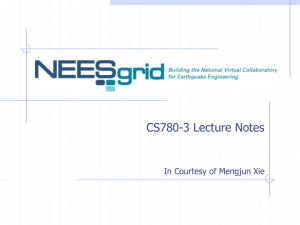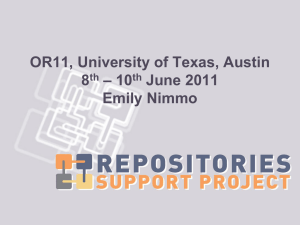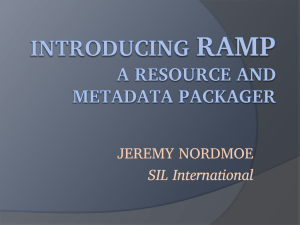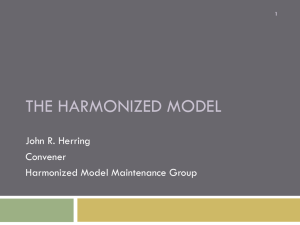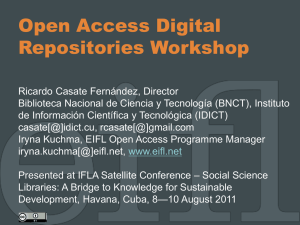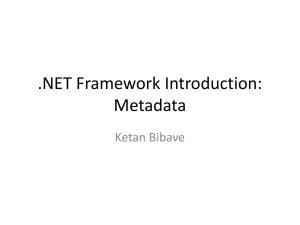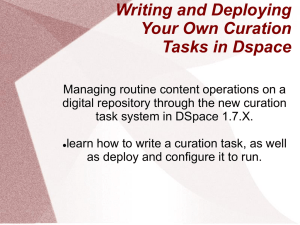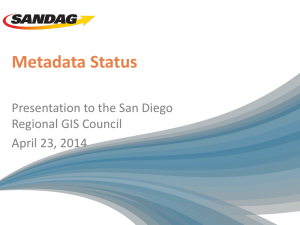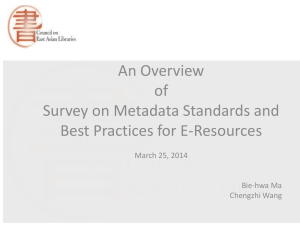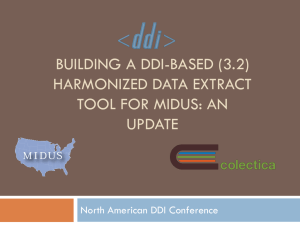8 - UM Personal World Wide Web Server
advertisement
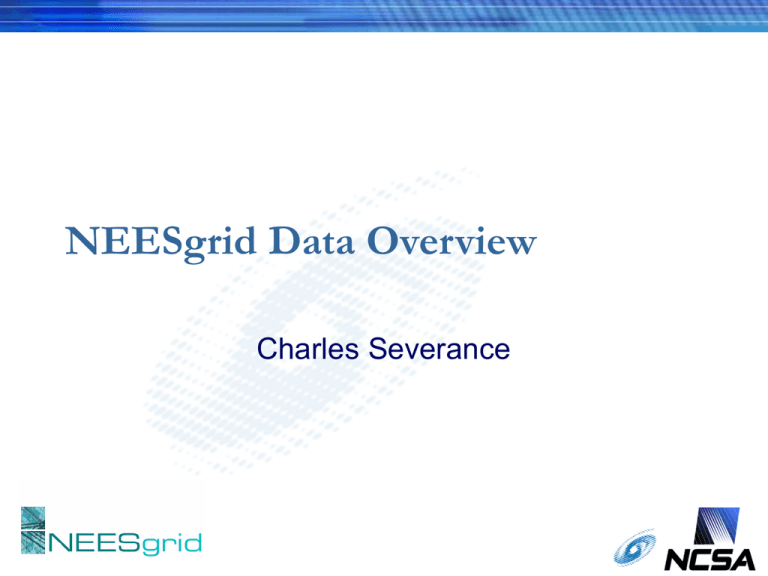
NEESgrid Data Overview
Charles Severance
Goals
Operates both as local and central (curated)
repository using same toolset
Object oriented - referential integrity - data and
metadata are supported together
Data migration and replication transparently including
security, and metadata
Uses Grid Services throughout (OGSA/GT3)
Easily used access controls - Grid as “single sign on”
Data provenance
Data in support of research publication
Support for repeatable experiments
Data oriented research computation support
Support for workflow
Vision: data on the Grid
Data
Meta Data
Gathering
Extracting
Repository
Mapping
studies
NEESgrid Data – Core Elements
Local Repository
Central Repository
JAVA APIs – Run locally on the same system as a
repository or over OGSA Web Services
– NEES File Management Services
– NEES Meta Data Services
Data Viewers
– Streaming (numeric, X/Y graph)
– Stored (X/Y graph, 2-D structure, video)
Core Elements
Data Acquisition
NEESpop
API
Data/MD
Ingest
Tools
Local
Repository
Workstation
API
Data
Teamlets
NEESdata
Data tools
API
Data viewers
Data
Teamlets
Central
Repository
NEESgrid Data – Technologies
Grid
– GRIDFTP is used for data transport
– Grid Web Services are used to insure security and
provide access control between systems over the
Internet – also provide for credential passthrough
– Grid credentials are used as part of login providing
a single sign-on framework
CHEF
– Provides a flexible mechanism for deploying GUI
tools like the data viewers and data browsers.
A Simple Experimental Scenario
Developer System
Labview
Test Specimen
DAQ System
Glue
Researcher System
A Simulation Scenario
Developer System
Simulation System
Simulation System
Simulation System
Code
Code
Code
The MOST Scenario
Part of the run-up to NEESPop 2.0
–
–
–
–
–
Used Beta of NEESpop and Beta of CHEF
Tested the data ingestion
Tested the metadata capabilities
Developed sample metadata
Tested mapping capabilities
System still available at
https://cee-nees.cee.uiuc.edu/chef/
Colorado
Test Specimen
LabView DAQ
MatLab Host
And Real-Time
Target Control
System
UIUC/Newmark
Test Specimen
Sim Controller
Shore-Western
LabView DAQ
UIUC
Matlab
NEESPop (1.1)
NSDS
NTCP
CO
Incoming
FTP
NTCP
Ingest
Repository
NCSA
CO
UIUC
NCSA
Meta
NSDS
NEESPop (1.1)
NTCP
UIUC
NEESMost (Win XP)
Matlab
Computational
Model
Site / Location
Computer
Ingest
Incoming
FTP
NEESPop (2.0)
NCSA
Ingest
Ftp
NTCP
Process
Series of files
Complete file (aggregated)
MOST Data Flows
Wires
NFMS/NMDS
Plug In
NSDS
File I/O
DAQ
0
5
5
0
0
2
3
3
3
6
3
3
4
4
8
The experiment was
viewed using the
standard NEES
stored viewer with
synchronized video
and data and the
ability to move back
and forth
NEESpop 2.0 Alpha
Metadata
Time
0.00
0.01
ch01 ch02
3
6
4
8
DAQ
0 3 4
0 6 8
<experiment>
<blah>
<public-view>
</experiment>
University of
Minnesota
0 3 4
0 6 8
<experiment>
<blah>
<public-view>
</experiment>
NEES Markup Language (NEESML)
Provides an RDF-like structure capable of
representing semantic information
– XML is the syntax which is used
– Logic is more “object oriented”
• Can define objects
• Can create objects
• Can reference objects
RDF/XML Versus NEESML
NEESml is topologically equivalent to RDF but more
straightforward to use
– A compromise between usability and functionality
– Focused on solving the problems of ingesting types and data
– rather than “cross-server ontology webs”
– Used to build a reference set of ingestion tools
– RDF is a moving target
Repository does not store either RDF or NEESML – It
is an relational database tuned to store “three-tuples”
There is a layer is where
we develop tools which
take advantage and
begin to depend on of
the “meaning” of the
data – where we begin to
depend on the meaning
of a second.
The Slide
Data Ingestors
m e a s u re m e n t
d is ta n c e
ra te
e s tim a te
m ile
n u m e ra to r
u n it
tra v e l
ra tio
d e n o m in a to r
m ile a g e
m odel
car
c o n s u m p tio n
v o lu m e
g a llo n
v e h ic le
flu id
gas
e ffic ie n c y
fu e l
Metadata
Data Viewers
Data Mappers
Data
Where we make a viewer
capable of viewing a
certain type of object.
This is where we build
things which make use
of knowledge.
This layer will never be
complete but it is a large
focus of the coming
months.
Looking for Data Models…
Looking for Semantics …
Strategies
Take Existing Data Models and Adopt
Build tools and data models at the same time
Find existing tools that produce types of data
we find interesting
Build meta data extractors for important file
formats
Build converters for things like Excel
Why start with the ORST Model?
It provides good coverage of a wellunderstood scope
It has consensus across multiple sites
A prototype toolset exists around the model
which is an important validation
http://nees.orst.edu/IT/data.model/
We can adopt the core elements and extend
as necessary
http://nees.orst.edu/IT/data.model/docs/v1.3a.july16.pdf
QuickTime™ and a TIFF (LZW) decompressor are needed to see this picture.
QuickTim e™ and a TIFF (LZW) de co m press or are ne ede d to s ee th is picture.
QuickTime™ and a TIF F (LZW) decompressor are needed to see this picture.
o:project
specialCondions
title
startDate
o:experiment[s]
o:role[s]
o:acknowledgement[s]
o:experiment
<type id="o:project" title=”Project">
<specialConditions title=”Special Conditions"/>
<title title=”Title"/>
<startDate title=”Starting Date"/>
<o:experiment allow="o:experiment” max="unbounded" />
<o:role allow="o:role” max="unbounded" />
<o:acknowledgements allow=“o:acknowledgement”
max=“unbounded” />
</type>
<type id="o:experiment" title=”Experiment">
<status title=”Status"/>
<title title=”Title"/>
<shortDescription title=”Description"/>
<o:facility allow="o:facility” />
</type>
<type id="o:experiment" title=”Experiment">
<title title=”Title"/>
<shortDescription title=”Description"/>
<longDescription title=”Description"/>
</type>
status
title
o:facility
shortDescription
title
o:facility
shortDescription
longDescription
Go Forward – Core Elements
Implement Access Control
Implement Replication
Investigate RDF and its relationship to
NEESML
Investigate provenance – would like to adopt
from another project
Investigate mapping – Would like to adopt
from another project
Go Forward - Tools
Evaluate the ORST interface and use it to implement
experiment-based interface to meta data repository
Investigate tools to represent structural data (like SAC data)
Extend and improve viewers – publish API so that sites can
extend the viewers
Improve notebook
– Single signon using CHEF/Grid credentials
– Integration with Metadata
– Smother integration with CHEF
Explore automated synchronized video and data capture and
after-experiment replay of synchronized video and data (ORST
UMinn)
Explore the capture of high quality still images as data (UMinn)
Investigate adopting a data-editing tool (XMLSpy)
Go Forward – Data Models
Analyze the ORST model, determine core,
convert to NEESML, pre-populate
repositories with types, and develop usage
documentation
Form core group between SI, ES, and CS to
push data model issues forward – once
groundwork is better defined – we can
disperse into distributed teams
Use experiment based deployment to help us
encounter new data needs over time
How to prioritize model
exploration and development
Focus on the following areas:
– Areas where we have or are building tools
– Areas where we already have incoming data in
some format
– Build the model through experiment based
deployment - solve real problems in an open way
and see if (with some adaptation) the solutions
apply more broadly (i.e. Minnesota )
What is in Release 2.0?
October 7
Groovy look and feel
Local Data Repository
Repository Browser in CHEF
– Improved visually
– Configured by XML
– Can read data from
repository or from urls
– Pre-populated with sample
video and data formats
– Browse
– Create objects
– Upload / download data
API documentation
NEESML User
Documentation
Extensible data mapping in
Java
Data Viewer in CHEF
Local Repositories prepopulated with
– SAC Data
– MOST Data
– ORST data model (subset)
NEESML
1 Introduction
NEESML is a means for populating a NEESgrid metadata repository with objects and
definitions of object types. It provides a syntax for defining object types and specifying
objects, the values of their properties, and the relationships between objects. The
NEESgrid metadata ingestion tool accepts NEESML files and uses them to populate a
repository with objects and type definitions, communicating with the repository with the
NEESgrid metadata service (NMDS) interface.
Table 1: Primitive types in NEESML
Name
Description
string
Text
int
Integer
long
Long integer. Can exceed
the size of an integer.
double
date
Double precision floating
point number.
A moment in time,
represented as a date and
time stamp in UTC with
1ms resolution.
NEESML can be used to share type definitions and objects between repositories, and as
an interface between other applications and repositories, because applications can either
be written to read and write NEESML files, or can be augmented with translation utilities
that translate the data formats they can read or write to and/or from NEESML. Finally,
NEESML can be used to archive metadata to files.
Examples
“Hello, world.”
This
document is 493-2584x”
intended as a comprehensive reference manual for the NEESML
“BN#
language. It does not explain how to use NEESML to represent real-world objects, but
1.1 About this document
rather completely specifies the syntax and meaning of every NEESML construct. Using
this document, you will be able to write NEESML documents that conform to the proper
syntax, and will be able to understand syntax errors and other problems with nonconforming NEESML documents or document fragments.
3
-2
For a more general introduction to NEESML, please refer to (Futrelle, 2003).
2147483647
Some NEESML-specific terminology is used in this document. The first time every such
term is used, it is italicized. Definitions of all special terms are given in the glossary in
section 7.
-5782347562427
9223372036854775807
NEESML is a general-purpose metadata description language. Throughout this
document, examples are used that do not directly pertain to earthquake engineering. This
is done merely in the interest of simplicity. All the constructs used in the examples can be
applied to metadata describing earthquake engineering experiments and simulations.
523425.4568574636
-0.0000000435234
NEESML documents are XML documents. There are some aspects of XML that
1.2 Some XML “gotchas”
constrain the syntax of NEESML documents in important ways:
2002-10-27
XML element and attribute names are case-sensitive. “ID” is not equivalent to
“id”, and “MyTypeName” is not equivalent to “mytypename”.
15:40:32.048
Namespaces, if they are used as relation ID’s or the ID’s of types for which
objects are created, must be declared in an enclosing element.
1969-01-12
Some characters are not allowed in element names. It is common practice to only
00:03:48.774
use alphabetic characters and dashes. Colons and other punctuation are not
allowed.
For details on XML syntax, consult the XML specification (Bray, Paoli, SperbergMcQueen & Maler, 2000) or a good XML reference or tutorial.
Repository Browser
Ingestor
NFMSUploadAgent.java
API Documentation
Configuring Events
<event id="oregon" desc="Oregon Large Tank Test September 8, 2003"
host=“/chef/org.nees.repo.data/retrieve-data?lfn=nacse_sample_01.txt&amp;
static=yes&amp;mapping=nacse-" type="stored">
<channel id="00" desc="time" unit="Seconds" url="t" />
<channel id="01" desc="Offshore Wave Gauge" unit="" url="02" />
<channel id="02" desc="Wave gauge at the front face of the cylinder" unit="" url="03" />
<channel id="03" desc="Wave gauge at the back face of the cylinder " unit="" url="04" />
<channel id="04" desc="Pressure at the front face of the cylinder " unit="" url="05" />
<video id="01" desc="Video of cylinder"
url=“/chef/retrieve-data/static/nacse_sample_01.avi" />
</event>
<type id="nees:storedEvent">
<data allow="io:file"/>
<url/>
<parseOptions/>
<storedTimeChannelsmin="1" max=“1" allow="nees:storedTimeChannel"/>
<storedDataChannels min=“0" max="unbounded" allow="nees:storedDataChannel"/>
<storedVideoChannels min=“0" max="unbounded" allow="nees:storedVideoChannel"/>
<storedStruct2DChannels min=“0" max="unbounded" allow="nees: stored2DStructureChannel "/>
<fileChannels max="unbounded" allow="nees:fileChannel"/>
</type>
We may be able to get a patch out to switch this to NEESml and provide a simple entry tool.
Mappings and the Data Viewer
NSDS (ISO 8601 Time channel)
Column data with time recorded as a column
Column – generate time
Column – generate time – trigger filter
Channel units: g,g,in,kip
Time ATL1 ATT1
2002-11-13T15:48:55.26499 -0.006409 0.004272
2002-11-13T15:48:55.36499 -0.005798 -0.003662
100.000
0.435 0.161 -1.016 -0.981
0.430 0.161 -1.016 -0.977
0.435 0.161 -1.016 -0.977
public class NEESDataMap
{
public static boolean repoMap(File mainFile,
File mappingFile, String mapping)
{
// Code here
}
}
Release 2.1 Data Aspects
December 2003
NEESpop
–
–
–
–
Notebook to metadata repository connection made
Closer integration of notebook into CHEF
First release of experiment tool (based on ORST)
Retool data viewers to be completely driven by
Metadata objects rather than their own objects
– More fine grained access control
– Enhanced data models
Tools
– Ingestion tools released
– A limited set of pre-release video/image tools
Further releases
Release 2.2 – March 04
– Driven by your needs as we encounter them
– Perhaps some “nice to haves” from the SI team
Release 3.0 – June 04
– Very limited new functionality – maybe almost
nothing new in the core components of the
NEESpop
